Historic Newspapers from Charlotte and Mebane Now Online
Early newspapers from Charlotte and Mebane have just been added to the North Carolina Newspapers collection.
Viewing search results for "Charlotte Mecklenburg Library"
View All Posts
Early newspapers from Charlotte and Mebane have just been added to the North Carolina Newspapers collection.
To celebrate 14 years of NCDHC (on May 12, 2009 our first blog post went live with our first scanned collection), the staff of the North Carolina Digital Heritage Center have all picked a favorite item from the collection to share. Check them out below – and then we invite you to visit digitalnc.org and find some favorite NC items yourself!
Lisa Gregory, Program Coordinator for the NCDHC
When pressed to pick one item (!) I have to go with the September 26, 1874 issue of the Fayetteville Educator. The Educator ran for a single year and was published by W. C. Smith who went on to publish a later title, the Charlotte Messenger. A few years ago while researching Black newspapers in North Carolina, I happened to run across a reference to the Educator as the earliest known Black newspaper in the state. Other sources generally cite the Star of Zion, which began a short time later and is still published today. With the help of some of our partners we were able to locate and add the Fayetteville Educator to DigitalNC. I picked this item because many 19th and 20th century newspapers written by and documenting the Black community are no longer extant or are extremely rare. For me, the fact that we can now share this online on behalf of our partners really encapsulates why we do what we do at NCDHC.
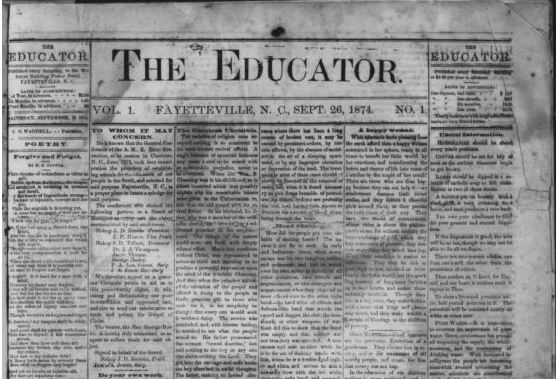
Stephanie Williams, NCDHC Programmer
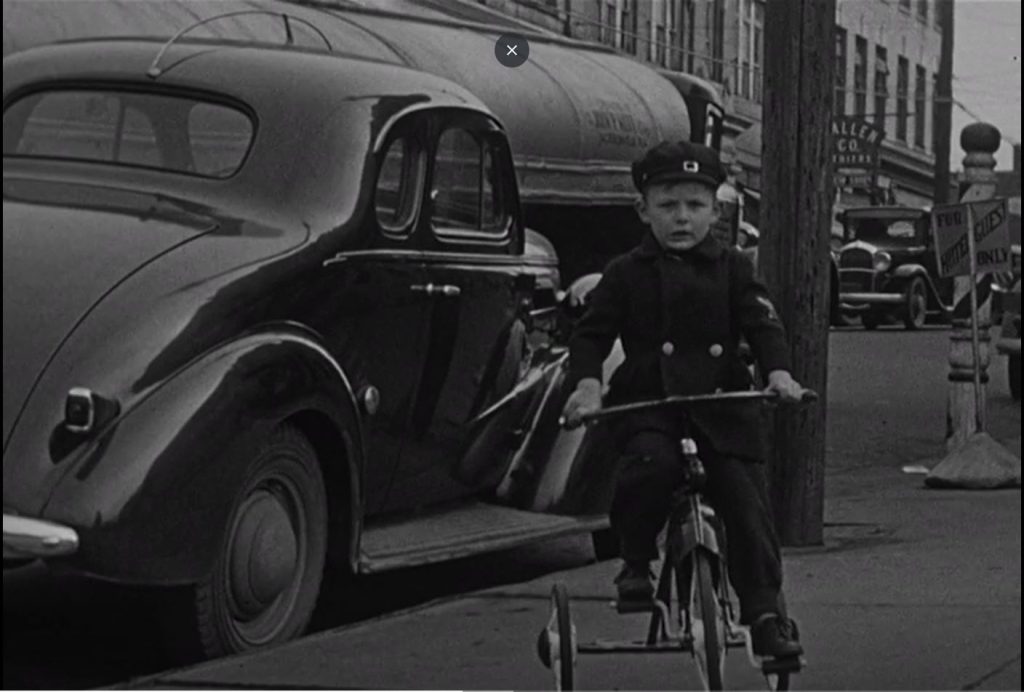
Movies of Local People (H. Lee Waters): Wadesboro, 1938
H. Lee Waters traveled around the state in the 1930s and 1940s setting up a camera on streetcorners and filming townspeople. There are a handful of these films available on DigitalNC, and one of my favorites is from Wadesboro in 1938. Waters captured people just going about their daily business, which is fun for so many reasons–but my favorite part is seeing peoples’ personalities, and realizing that the way we react when we realize we’re on camera hasn’t changed in 85 years.
Kristen Merryman, Digital Projects Librarian
“Adult feeding bear by Fontana Lake”
This is a photograph in our collection I always come back to because it really pulls together many things I love – bears, the gorgeous lakes of the NC mountains, and a good cookout in a park. This obviously portrays something many a park ranger would shun but I love the NC Variety Vacationland vibes it gives off! We digitized this photograph as part of a larger batch from the Graham County Public Library in Robbinsville, NC when we were there for an onsite scanning visit in 2018 and ourselves got to enjoy many lovely views of Fontana Lake and the surrounding mountains.
Sophie Hollis, Education & Outreach Assistant
“Wake Forest University Student Handbook [1987-1988]“
One of the things I love about our site is how many yearbooks, student handbooks, and students newspapers we have—I love seeing family and friends’ photos from when they were in school. These materials are where I see my own life reflected the most because they capture so many familiar places and people. It’s interesting to see how our schools have changed over the last century but also how so many things are apparently inherent to being a teenager. While I think all of our student publications are fantastic, this handbook is special to me for a few reasons. Not only is it a glimpse at my alma mater (go Deacs!), but it also features an excellent photo of one of my favorite professors in his early years of teaching.
Geoff Schilling, Newspaper Technician
Cat’s Cradle
The DigitalNC item I chose is of a Chapel Hill location that means a great deal to me. The first four photos in this set are of the Cat’s Cradle’s early to late ‘80s location at 320 W. Franklin St. (now The Crunkleton), but the last three images are the reason I’m sharing it. Down this alley is their previous location at 405 1/2 W. Rosemary St., which they started occupying around 1971. In 1983, after the Cradle moved out, it became a venue called Rhythm Alley and they stuck around until 1987. At the end of that year the Skylight Exchange took over the space and in 2003 the one-and-only Nightlight came into existence.
The Nightlight is an experimental music oasis where you can see everything from outsider folk legend Michael Hurley to Detroit techno heavyweight DJ Psycho. In addition to being my favorite venue in the world, it’s also the preferred stop of touring musicians from all over the country. The landscape of this “Rhythm Alley” has barely changed over the last half-century (save for a healthy amount of graffiti), but its legacy has grown with each new chapter.
The photographs were courtesy of our partner Chapel Hill Historical Society.
Ashlie Brewer, Digitization Technician

Last year I had the opportunity to digitize some amazing slide images that were taken during several Chapel Hill Boy Scout Troop 835 and Girl Scout Troop 59 trips over the years courtesy of our partner Chapel Hill Historical Society. Many of the slides from these trips feature beautiful scenery and fun, but this particular photograph from the August 1973 Quebec trip is one of my favorite items on our site. In addition to being a great candid, I think it’s the individual’s sense of jollity and peacefulness portrayed in this moment of the trip that really makes it a top-pick of mine.
Today’s post is the result of a chance quote and a successful collaboration. We’re pleased to add to DigitalNC the earliest newspaper published by and for North Carolina African Americans – the Fayetteville Educator – along with another early African American newspaper, the Charlotte Messenger.
The North Carolina Digital Heritage Center’s partners have shared a really robust collection of African American papers, and we’re always searching for more. In addition to what’s on DigitalNC, we’re familiar with other well known early papers like the Star of Zion — one of the oldest (1876) as well as the longest continuously running paper in the state. On DigitalNC you’ll find another early paper, the National Savings Bank. Published in 1868, the paper featured advertising and news related to the banking industry. It was published for African Americans from a number of locations around the U.S., including New Bern. The content is mostly syndicated across all of its issues and it was intended for a national audience.
Earlier this year, while reading about African American newspaper editor, William C. Smith, we ran across this quote:
He was one of the founders of The Fayetteville Educator, the first newspaper edited and published by colored men in North Carolina.*
The Educator wasn’t a paper we had run across before. After a few inquiries, we found two institutions who were familiar with the paper. The Harvey B. Gantt Center for African-American Arts + Culture in Charlotte has been stewarding original copies of the Educator – possibly the only extant copies – as well as the Charlotte Messenger for years. They had shared microfilmed copies of both papers with one of our partners, the Charlotte Mecklenburg Library, which had cataloged that microfilm into their catalog allowing us to find it online. Thanks to the cooperation of both of those organizations, we’re happy to share these newspapers on DigitalNC today.
Founded by William C. or W. C. Smith, the Fayetteville Educator ran for a single year – September 26, 1874 through September 25, 1875. The first issue states that the paper’s “efforts will be directed to training the intellectual and moral sentiment of our youth” and that it is “printed and edited by colored young men.” The paper does include reports of the actions and events of the A. M. E. Zion church in North Carolina as well as many moral and anecdotal stories, poetry, and lifestyle recommendations for young men. However, it is also Republican in sentiment during a time when the North Carolina Republican party was trying to stave off disenfranchisement of the African American community by their Democrat counterparts. In the first issue, the paper states that, while “indebted” to the Republican Publishing Company, the paper hoped that “others of different political faith show that they too are friendly.” The paper was eventually suspended because it considered its work complete and because it lacked patronage to continue:
“We are confident that we have done our duty, having stood by the party during the hottest campaign of the last decade, and witnessed success, even in redeeming our own and surrounding counties, we are assured that our work has not been in vain. We regret that our patronage is not sufficient to insure another year’s success…” September 25, 1875, page 2, pictured at right.
The work Smith refers to was keeping governmental control out of Democrat hands. Unfortunately, he called a premature success as less than a month after the final issue Democrats slyly eked out a narrow majority in the Convention of 1875. In the following years North Carolina Democrats implemented a number of laws that either overtly or obliquely upheld racism in the state’s political and social systems.
While the Educator was never revived, William C. Smith went on shortly thereafter to begin another newspaper, the Charlotte Messenger. The same book cited above, which mentioned the Educator, describes the Messenger as a paper that fought “against intemperance, immorality, and all other evils coming its way.”** Reading from the salutatory message on the second page of the first issue you’ll see many similarities from the Educator.
In presenting this little sheet to our people, it is hoped that they will appreciate it as an honest effort on our part to promote the moral, intellectual and material standing of our people. We are aware of the difficulties and responsibilities attending the publication of a newspaper; but seeing the great need of an organ in this section to defend the principles of the Republican party; the need of an exponent of the rights of the colored people, we have undertaken the task and shall depend upon the wisdom and kindness of our friends to encourage and support us.”
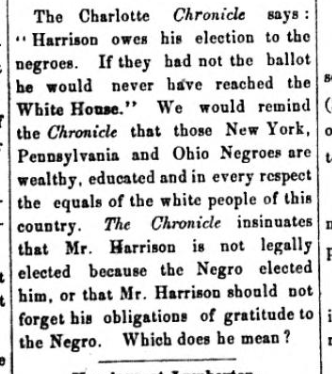 The Messenger began on June 17, 1882 and continued at least until 1891. The microfilmed issues that we’re able to share last from the June 17, 1882 issue through January 5, 1889. Issues include syndicated news from big city papers and other areas of the south, as well as the traditional repeated poetry, short stories, and advice found in many newspapers at this time period. But you’ll also find the regular “Fayetteville Notes” and other areas of that paper highlighting local news. Temperance is a continuous theme, as are other tenets of the Republican party at that time. The editors occasionally commented on news printed in the Charlotte Chronicle, the Messenger’s contemporary, like the example at right which mentions the 1888 election of President Benjamin Harrison.
The Messenger began on June 17, 1882 and continued at least until 1891. The microfilmed issues that we’re able to share last from the June 17, 1882 issue through January 5, 1889. Issues include syndicated news from big city papers and other areas of the south, as well as the traditional repeated poetry, short stories, and advice found in many newspapers at this time period. But you’ll also find the regular “Fayetteville Notes” and other areas of that paper highlighting local news. Temperance is a continuous theme, as are other tenets of the Republican party at that time. The editors occasionally commented on news printed in the Charlotte Chronicle, the Messenger’s contemporary, like the example at right which mentions the 1888 election of President Benjamin Harrison.
We hope you’ll take a chance to delve into these two papers and the other African American newspapers on DigitalNC.
_____
* I. Garland Penn. (1891) The Afro-American Press and Its Editors. p. 270
** –. p. 272
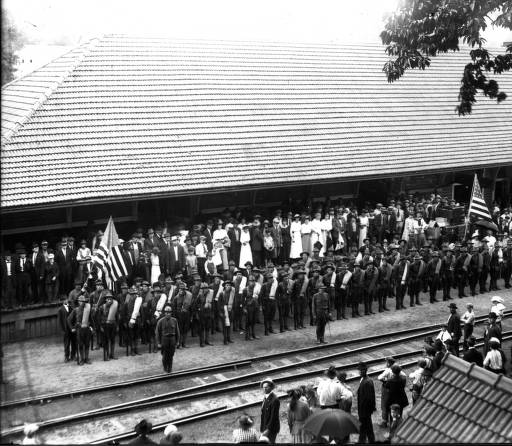
Company H, WWI, 1st North Carolina Infantry of the National Guard, departed Waynesville’s train depot on June 26, 1916. They guarded the Mexican border and returned to Waynesville in February 1917. In July 1917 they then were sent to France during WWI. Courtesy of Haywood County Public Library.
Last Thursday, April 6, 2017, marked the 100th anniversary of the United States’ entry into World War I. Over the next year, many cultural heritage institutions around the country are highlighting the materials they hold related to the “Great War.” We wanted to highlight some of the fantastic local North Carolina materials we have digitized for our partners that document the World War I perspective from North Carolinians’ eyes.
Service records, photographs, news clippings and letters back home from communities across the state are digitized here on DigitalNC. From Wilson County, we have a set of records from 70 men that served in the war that the United Daughters of the Confederacy collected and a scrapbook that includes letters from a Robert Anderson before he was wounded in action and died in France. From Stanly County, we have an enlistment record that includes the amount Harvey Jarvis Underwood was paid to serve, and a history of the service records of Stanly County men who served in the war. From the Grand Lodge of the Ancient, Free, and Accepted Masons of North Carolina, the NCDHC digitized a list of all the North Carolina masons who died in World War I.
Several scrapbooks from Elon University detail the students’ view of the war as well as what college life during World War I looked like here in North Carolina.
The richest source of information on World War I and North Carolina on DigitalNC may very well be the many local newspapers we’ve digitized that contain the local perspective on the war, including some quite subdued headlines announcing the US’s entry. DigitalNC also hosts several World War I camp and hospital newspapers including the Trench and Camp from Camp Greene and the Caduceus, the paper of the Base Hospital at Camp Greene. Both are from Charlotte Mecklenburg Library.
To view more materials from World War I, check out a search of our collections here. And to learn more about World War I materials from across the state, visit the institutions highlighted in this blog post from our colleagues over at the State Archives of North Carolina.
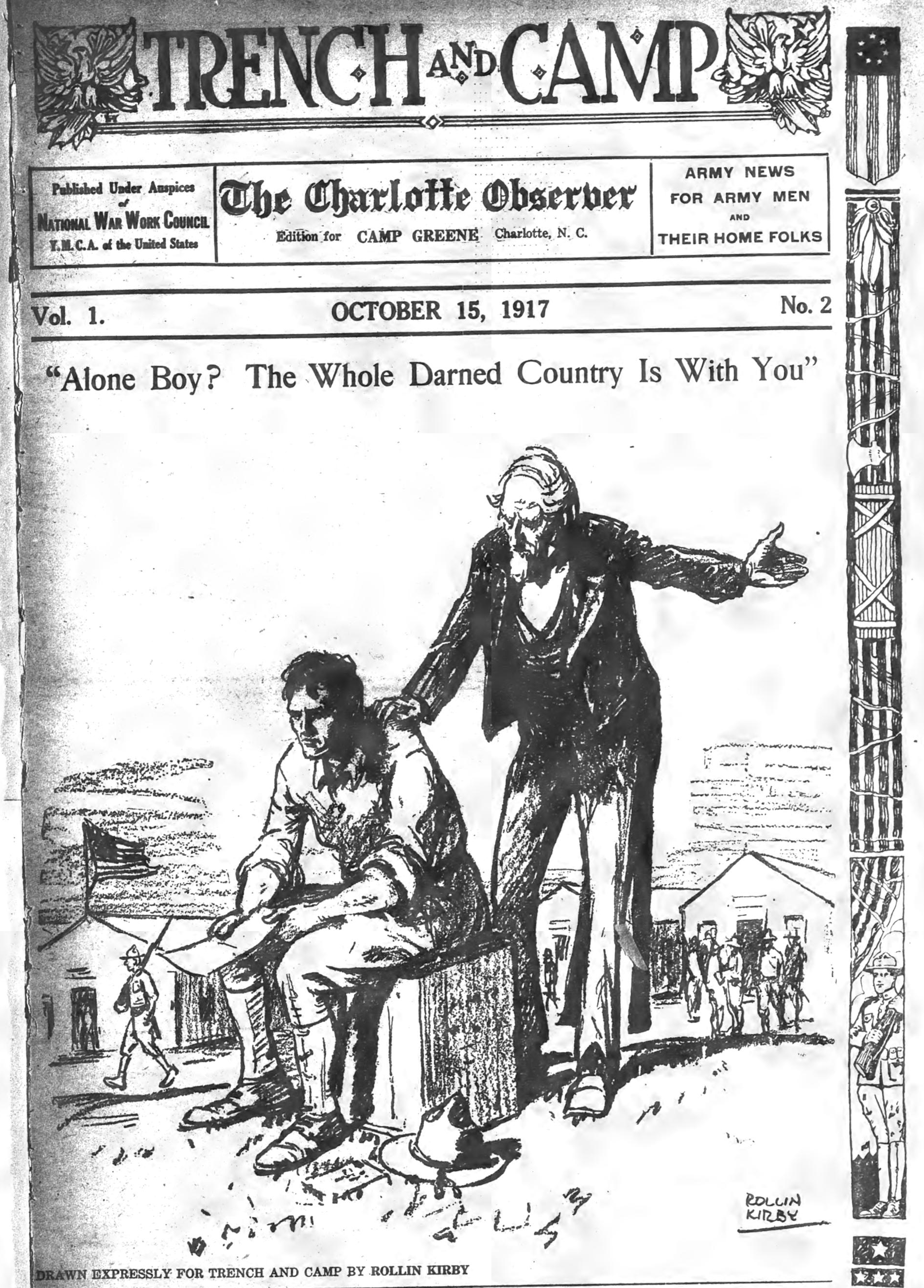
Trench and Camp, October 15, 1917, page 1
53 issues of the “Trench and Camp” are now available on DigitalNC courtesy of the Charlotte Mecklenburg Library. They cover October, 1917 through December 1918.
The Trench and Camp newspaper was published for soldiers living in the 32 domestic cantonments during World War I, like those living at Camp Green in Charlotte. Published by the National War Work Council of the YMCA and in partnership with local city newspapers (these issues were published in partnership with Charlotte Observer), the Trench and Camp was filled with information that would be important for the activities and moral of soldiers who were often far from home. The central New York editorial office supplied half of the material and the local publisher supplied the second half, as well as the adds.
These editions are excellent resources for those interested in communication during war time, as these papers were seen as direct communication between the President and those serving their country. They also contain some great illustrations, like those seen in this post.
The historical information used in this post can be found in the Kautz Family YMCA Archives at the University of Minnesota, which holds many editions of the Trench and Camp from the other 32 domestic camps around the United States. To learn more about our contributor, the Charlotte Mecklenburg Library, please visit their contributor page or their homepage.

Trench and Camp, April 08, 1918, page 1
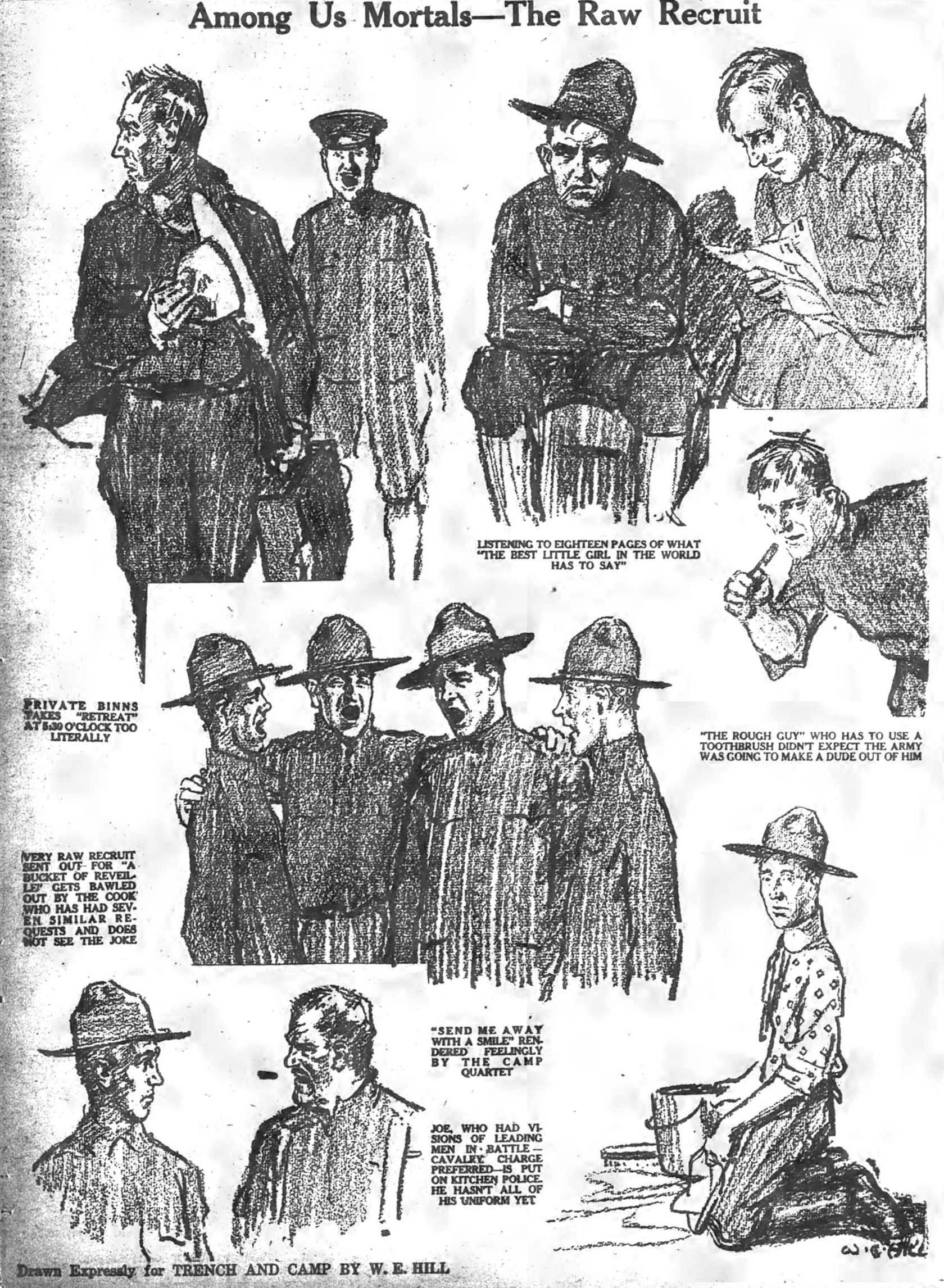
Trench and Camp, October 29, 1917, page 1
In the early 1960s, North Carolina’s state government created a Film Board to “portray and illuminate the people, problems, themes, and life of the State” (Oettinger 1964/1965, p. 1). Championed by Governor Terry Sanford, the Board operated from 1962-1965 and created 19 films. As part of our recent audio-visual project, the Charlotte Mecklenburg Library and the North Carolina Collection at UNC-Chapel Hill’s Wilson Library contributed eight of these films for digitization.
During the Board’s operation, “ideas and requests for the films came from various state departments, individuals on the Governor’s staff or historical associations from around the state” (Ferrara 1981, p. 23). Production costs for each film averaged $30,000. James Beveridge, a filmmaker from Canada, was brought in to head the Board. (The State Archives has shared film clips from Beveridge online as well.)
The Board aimed to produce films that were documentary in nature, looking at different industries, locations, or segments of the population. Some addressed politically charged issues; the Minority Report series is a stark exploration of race relations. “Goodbye to Carolina,” was coordinated with the help of the Intercollegiate Council for Human Rights, chaired by then A&T student Jesse Jackson.
Below is a list of the films produced by the Board that are currently available on DigitalNC*:
It’s interesting to see the film topics chosen during this time period. Instead of shying away from hot button issues or glossing over the widespread demographic, economic, and social changes of the era, the Film Board tackled them with a freer hand than might be expected. Such ambitious and frank efforts eventually contributed to the Board’s dissolution.
You can view additional items on DigitalNC from the Charlotte Mecklenburg Library and the University of North Carolina at Chapel Hill.
Notes
*The other films are: Land of Beginnings; Minority Report: Vote and the Choice is Yours; Minority Report: We’re Not Alone; Nine Months To Go; The Outer Banks (possibly lost, according to Ferrara)
References
Ferrara, Susan E. “The Demise of the North Carolina Film Board: Public Policy Implications.” M.A. thesis., University of North Carolina at Chapel Hill, 1981.
Oettinger, Elmer. “The North Carolina Film Board: A Unique Program in Documentary and Educational Film Making.” The Journal of the Society of Cinematologists 4/5 (1964/1965): p. 55-65.
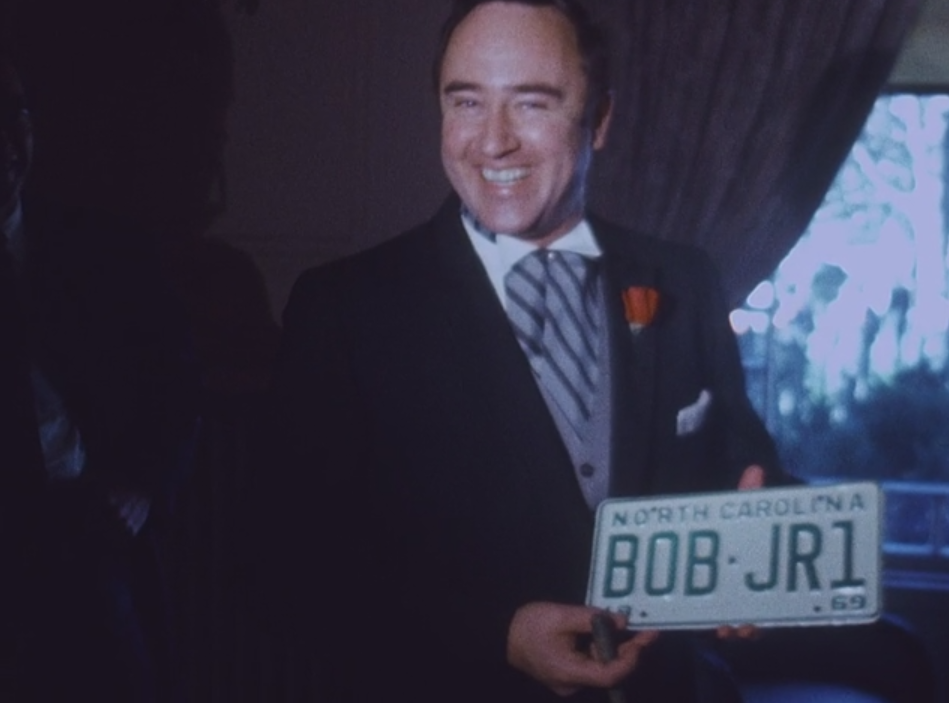
Governor Robert W. Scott receives a “Bob Jr.” license plate in this footage of his inauguration and subsequent celebrations. Contributed by the State Archives of North Carolina.
Almost one year ago, we asked our partners for nominations of audio and video media from their collections to digitize, using funding from the Digital Public Library of America. From all corners of North Carolina came suggestions for moving images and sound. Some items were well documented, with descriptions or finding aids [?] in tow. Others were accompanied with the words “We think this is … but we really have no idea.” Thanks to George Blood, L. P., who digitized these items for us, and Andrea Green, our former Community Digitization Manager, we ended up with over 140 physical items digitized from 11 institutions.
Here’s an overview of what’s been added to DigitalNC to our new Sights and Sounds collection (some of our partners will be posting their digitized media on their own digital collection sites instead). Stay tuned over the next few weeks for more posts taking a closer look at some of our favorites.
Throughout the 1990s, Mary Lewis Deans spearheaded an ambitious and well-documented oral history campaign in Nash County. She and her colleagues spoke with long-time residents about rural farming life, military service during World War II, segregation, and family traditions. Deans was businesslike yet friendly, no-nonsense and yet genuine. Listen to and read Deans’ oral histories.
Three of the films contributed by Charlotte Mecklenburg Library help document the history of Charlotte. The Charlotte Mecklenburg United Appeal campaign from 1952 shows numerous Charlotte places.
From Davie County Public Library comes a two-part series on Davie County History, and a home video of local personality Louise Graham Stroud, who performed monologues as her self-created character, “Miss Lizzie.”
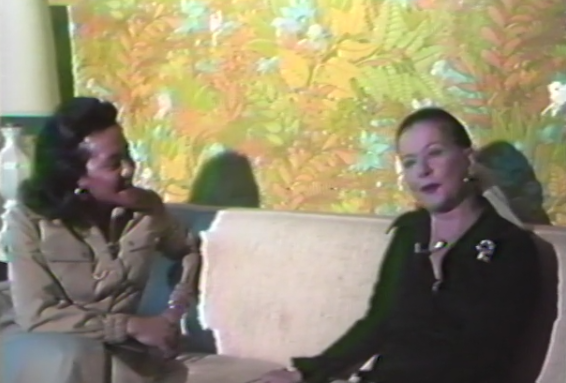
Cynthia Watts (left) interviews actress Joan Bennett in one of the Arts in Durham films contributed by the Durham Public Library.
Love Durham? Love the Arts? Love the late 70s? Some of our staff favorites come from Durham Public Library’s collection of “Arts in Durham” films. Produced by the Durham Arts Council, these films showcase local bands, dance groups, visual artists, and more. We’ll definitely be blogging about our favorite moments. Durham Public Library also contributed a taped lecture by Dr. Charles Watts on the history of Lincoln Hospital, and two-part coverage of the Durham County Centennial Parade of 1981.
Tobacco Perspectives is an amateur recording of a two-night event in the early 1980s during which a historian, a political scientist, and representatives from farm, industry, and public health agencies lectured on the tobacco industry both past and present.
We’ve already announced the bookmobile film from Rockingham County, but we’re still looking for someone who can identify the school that’s shown. In this film boys and girls eagerly peruse and check out books from local librarians. It’s even got Jim, the library dog.
We were pleased to join for the first time with the State Archives during this project, as they chose a number of films that document the state’s history. Among the films from the Archives that we’ve added online are coverage of Governor R. W. Scott II’s inauguration and U. S. Coast Guard Appreciation Day (1970).
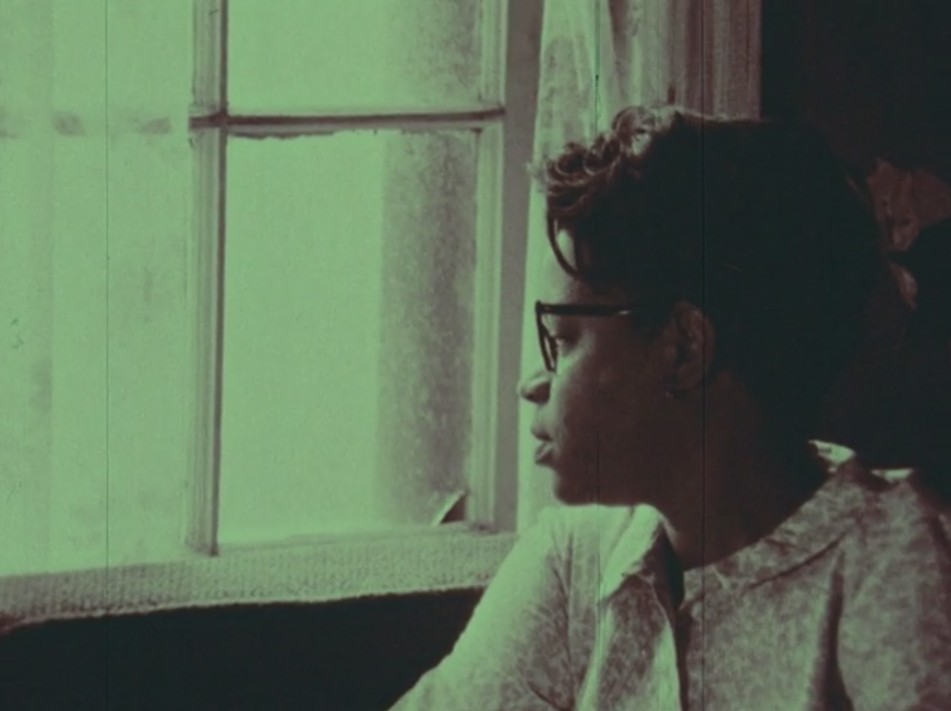
No Handouts for Mrs. Hedgepeth, 1968, documented a Durham family living below the poverty line. Contributed by the North Carolina Collection, UNC-Chapel Hill.
From 1962-1965, the North Carolina Film Board produced films tackling some of the most pressing issues in North Carolina: race relations, education, and economic opportunity. Eight of those films join others from the North Carolina Collection and Southern Historical Collection at UNC-Chapel Hill on DigitalNC. As might be expected, some are about UNC and Chapel Hill. Fans of the Hugh Morton Collection will also see several films believed to have been filmed by Morton or his colleagues. There’s even footage of Mildred the Bear.
In 1960, Dr. Bertha Maxwell-Roddey became the first chair of what is now the Department of Africana Studies at UNC-Charlotte, which contributed three items related to her career. A scholar, educator, and community icon, one of these shows children in a classroom being taught by Maxwell-Roddey’s students. The others show a night of live poetry and music.
We hope you enjoy North Carolina’s Sights and Sounds. Click to view all of the films and oral histories together.
The following newspapers were digitized from microfilm in 2011 and 2012.
| Title | Years | Nominating Institution |
|---|---|---|
| The Mebane Leader | 1911-1915 | Alamance County Public Library |
| Highland Messenger (Asheville) | 1840-1851 | Buncombe County Public Library |
| The Standard (Concord) | 1888-1898 | Cabarrus County Public Library |
| Daily Concord Standard | 1895-1899 | Cabarrus County Public Library |
| Mecklenburg Jeffersonian (Charlotte) | 1841-1849 | Charlotte Mecklenburg Library |
| Miners’ and Farmers’ Journal (Charlotte) | 1830-1834 | Charlotte Mecklenburg Library |
| Catawba Journal (Charlotte) | 1824-1828 | Charlotte Mecklenburg Library |
| Western Democrat (Charlotte) | 1856-1868 | Charlotte Mecklenburg Library |
| North Carolina Whig (Charlotte) | 1852-1863 | Charlotte Mecklenburg Library |
| Fayetteville Observer | 1851-1865 | Cumberland County Public Library |
| The Carolina Times (Durham) | 1951-1964 | Durham County Library |
| The Lincoln Republican (Lincolnton) | 1840-1842 | Gaston County Public Library |
| The Lincoln Courier (Lincolnton) | 1845-1895 | Gaston County Public Library |
| The Roanoke News (Weldon) | 1878-1922 | Halifax County Public Library |
| The Marion Progress | 1916, 1929, 1940 | McDowell County Public Library |
| Marion Record | 1894-1895 | McDowell County Public Library |
| Marion Messenger | 1896-1898 | McDowell County Public Library |
| The Pilot (Southern Pines) | 1920-1945 | Southern Pines Public Library |
| Sylvan Valley News | 1900-1911 | Transylvania County Library |
| The Pinehurst Outlook | 1897-1923 | The Tufts Archives |
| The Goldsboro Headlight | 1887-1903 | Wayne County Public Library |
| The Elm City Elevator | 1902 | Wilson County Public Library |
| The Wilson Advance | 1874-1899 | Wilson County Public Library |
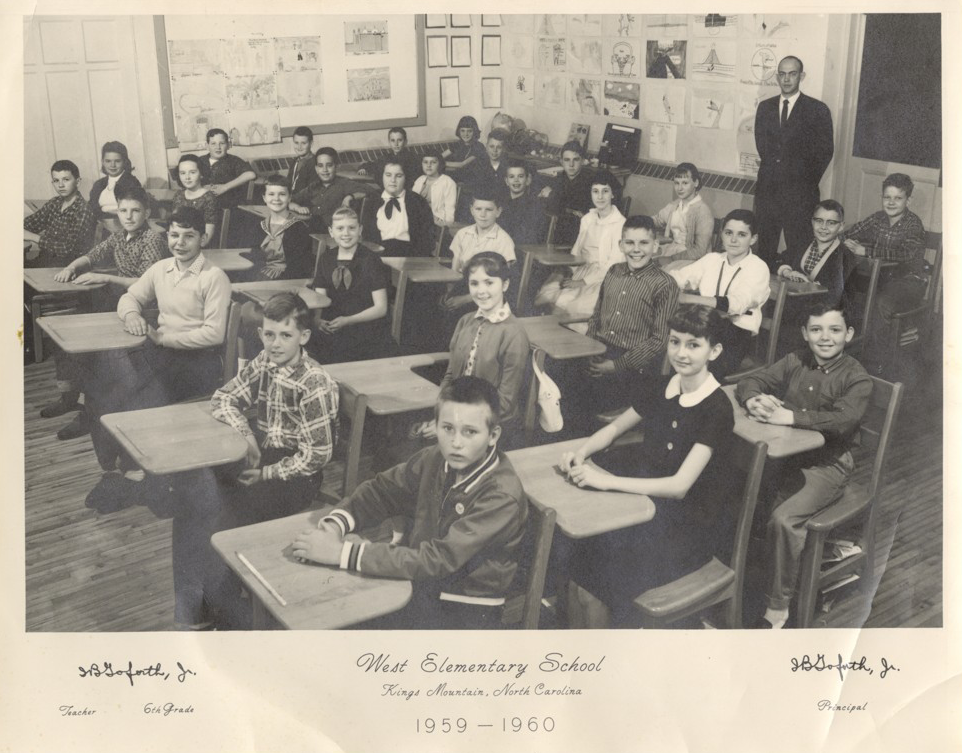
We are very excited to announce that our site has expanded to include four new sets of primary source teaching resources available for any teachers, researchers, or curious explorers to use. Each of these sets focuses on a particular topic in North Carolina history and includes a curated selection of 15-20 primary sources from our 300+ partners around the state. Within each set is a blend of visual materials (photographs, videos), written materials (newspaper articles, speeches, letters), and audio materials (interviews, oral histories) from the DigitalNC collections.
Each set also comes with short context blurbs for each item, as well as general background information, a timeline, a set of discussion questions, and links to genre-specific worksheets (ex. How to Analyze a Newspaper Clipping). While some of these topics are more concentrated in particular regions, our goal is to connect these broad themes in history to local examples that students can recognize. Here’s a look at the four initial primary source sets:
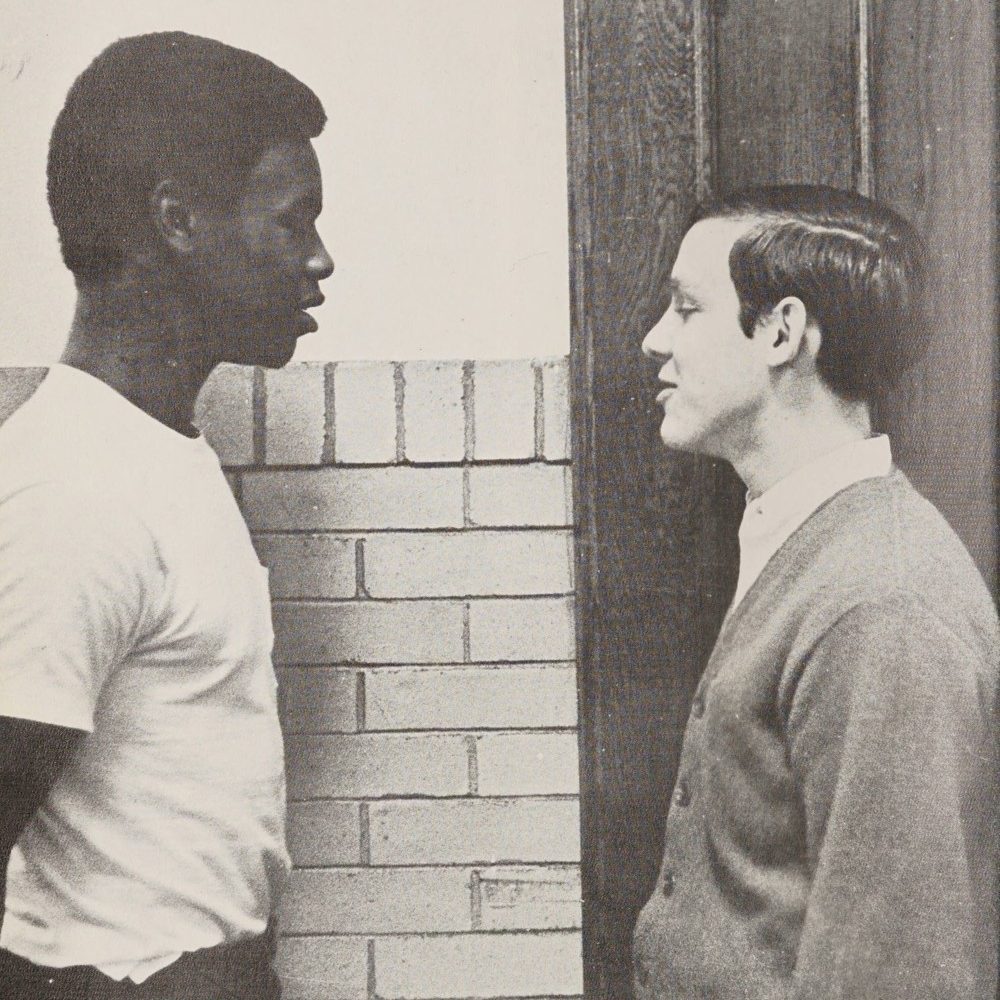
Racial Integration in K-12 Schools
Time period: 1950s-1980s
While you may be familiar with some of the national stories around school integration after Brown v. Board of Education, this teaching set samples North Carolina yearbooks, photographs, newspapers, and oral histories to ground this topic in familiar places. It draws primarily on our collections from historically Black high schools, many of which were closed during this period (though their alumni associations remain strong!). This collection also implements local materials from the Swann v. Charlotte-Mecklenburg Supreme Court case over busing.
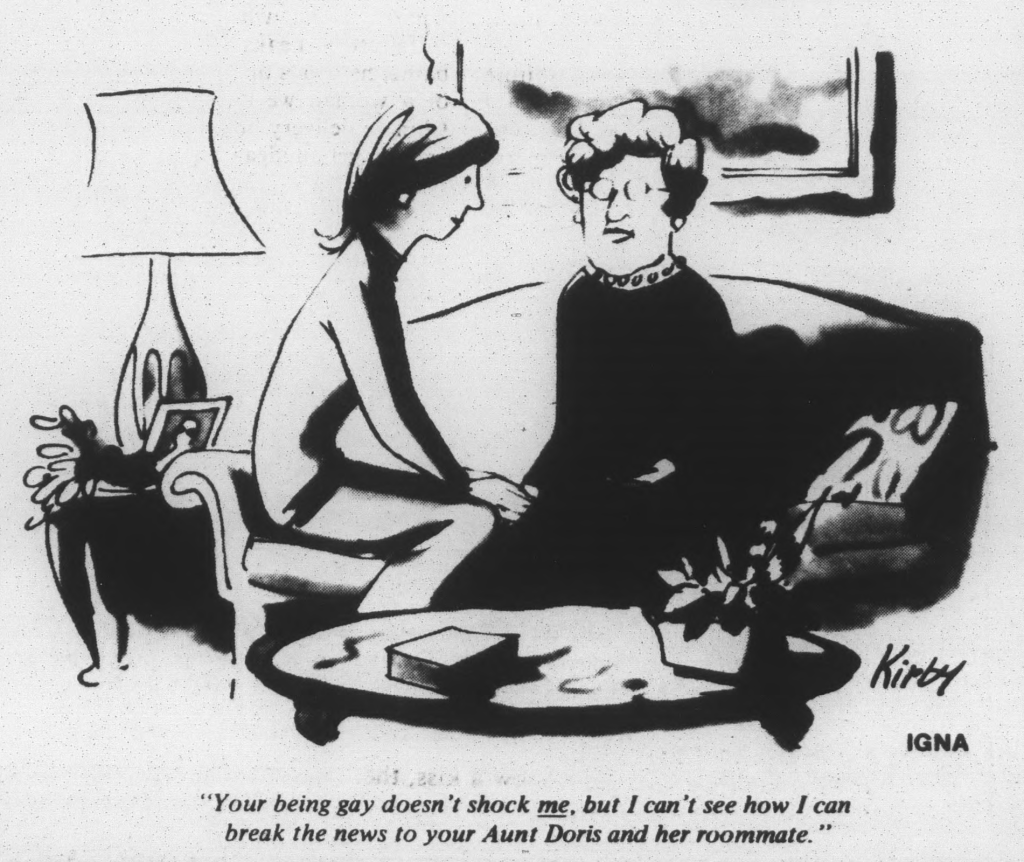
Time period: 20th century
This set was inspired by the popular NCPedia page, “Analyzing Political Cartoons,” which explains some of the strategies for understanding cartoons in their historical context. Here, we’ve selected examples from over a century of newspapers that include topics such as the 1898 Wilmington Coup, women’s suffrage, economics, and a few contemporary political issues. Each example comes with a bit of historical context and some background on the newspaper itself.
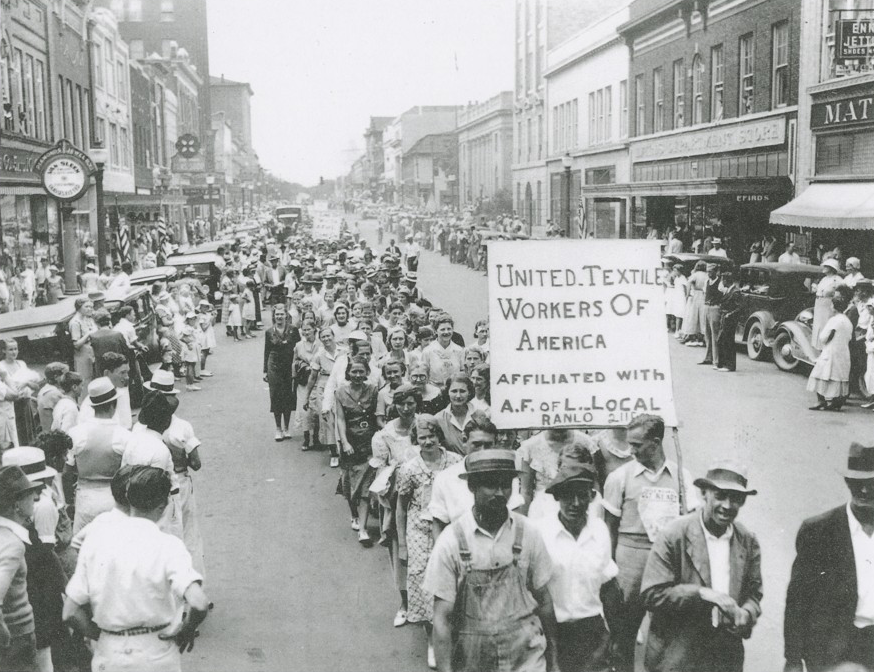
Textile Workers & Labor Movements
Time period: 1920s-30s and 1970s
North Carolina’s history of labor is inextricably tied to the legacy of the textile industry. This set uses photographs, memorabilia, speeches, and newspaper clippings of two famous examples—the Loray Mill strike of 1929 and the activism of Crystal Lee Sutton—to weave together an understanding of North Carolina’s economy and culture through one of its major industries of the 20th century.
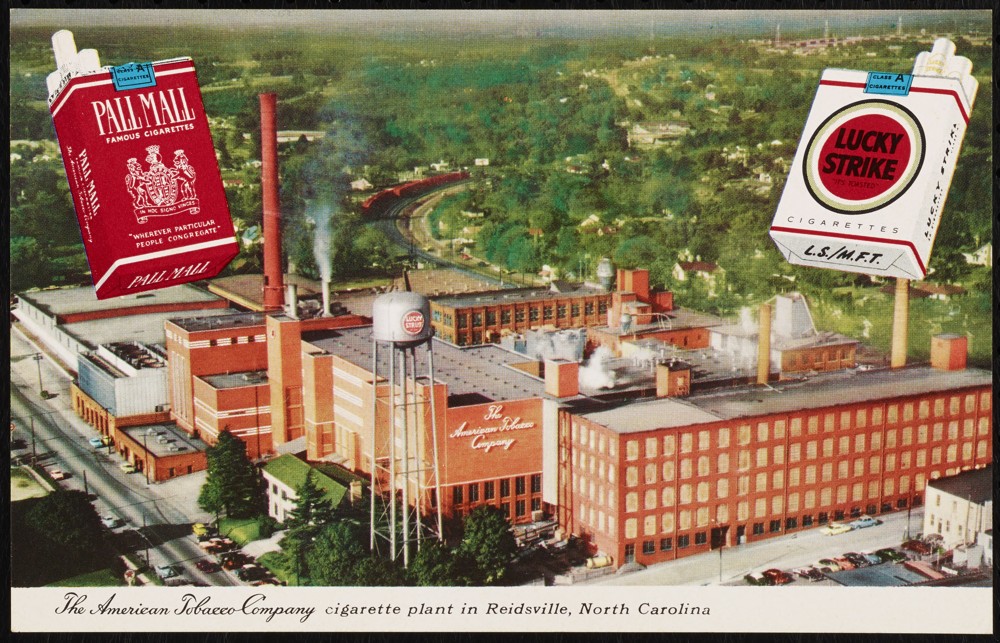
Time period: 20th century
It would be impossible to fully understand the history of North Carolina in the 20th century without talking about the tobacco industry. This set uses photographs, newspapers, videos, and oral histories to explore the lives of tobacco farmers and factory workers as well as the major families who controlled the vast tobacco wealth. Additionally, it includes examples of how the industry affected culture, including a new generation of advertising that attempted to combat public health concerns.
You can explore these four teaching sets for yourself here on our teaching and learning resource page. You can also go directly to our item analysis worksheets here, which include levels for both beginning and advanced learners. If you’d like to give us feedback on these teaching resources, you can contact us here.
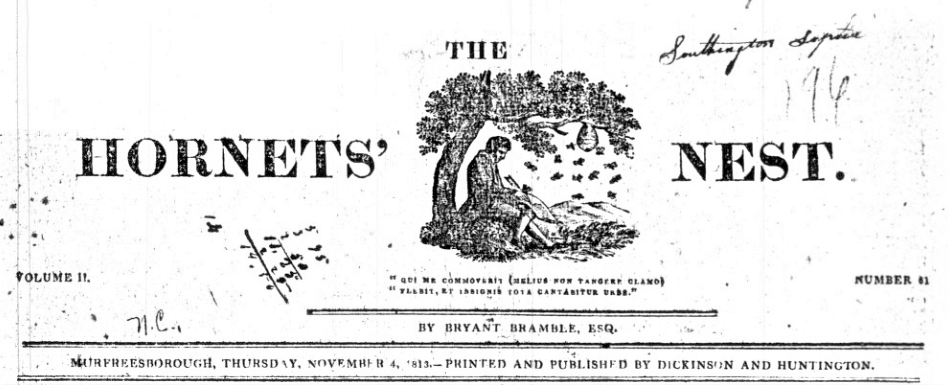
This week we have another 60 titles from all over the state up on DigitalNC, including a little piece of North Carolina railroad history!
On the second page of the January 15th, 1833 issue of the Fayetteville Observer, you’ll find a list of all the legislation enacted by the North Carolina General Assembly during the 1832-1833 session. One of these acts is the incorporation of the company that built North Carolina’s first functional railroad: The Experimental Rail Road Company of Raleigh.
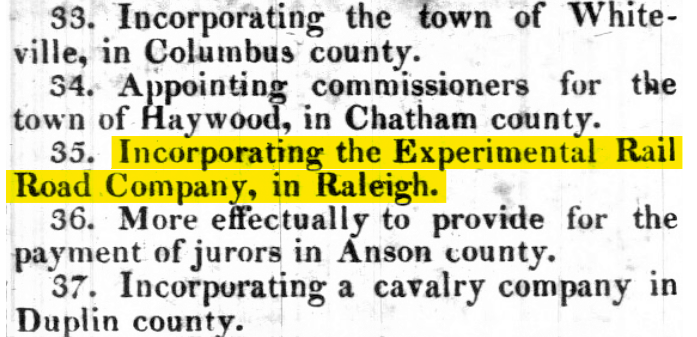
Fayetteville Observer, January 15, 1833
The one and one-quarter mile rail line extended from the Capitol Building, which had burned in 1831, to a quarry just east of Raleigh. When the horse-drawn rail carts weren’t transporting the stone used to rebuild the Capitol, people could ride the line in “pleasure cars” for a 25 cent fare. The line cost $2,700 to construct, which would be roughly $91,000 in 2022.
Over the next year, we’ll be adding millions of newspaper images to DigitalNC. These images were originally digitized a number of years ago in a partnership with Newspapers.com. That project focused on scanning microfilmed papers published before 1923 held by the North Carolina Collection in Wilson Special Collections Library. While you can currently search all of those pre-1923 issues on Newspapers.com, over the next year we will also make them available in our newspaper database as well. This will allow you to search that content alongside the 2 million pages already on our site – all completely open access and free to use.
This week’s additions include:
If you want to see all of the newspapers we have available on DigitalNC, you can find them here. Thanks to UNC-Chapel Hill Libraries for permission to and support for adding all of this content as well as the content to come. We also thank the North Caroliniana Society for providing funding to support staff working on this project.

This blog is maintained by the staff of the North Carolina Digital Heritage Center and features the latest news and highlights from the collections at DigitalNC, an online library of primary sources from organizations across North Carolina.